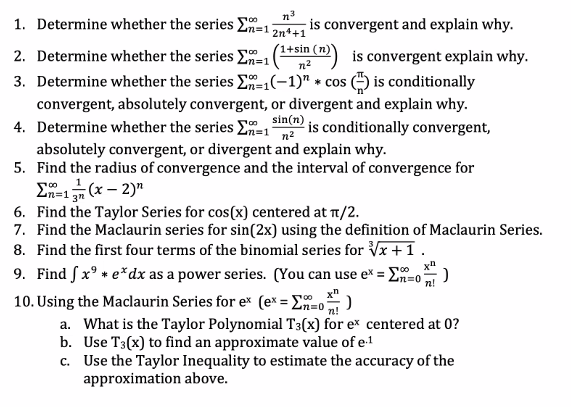Algebra & Trigonometry with Analytic Geometry
13th Edition
ISBN:9781133382119
Author:Swokowski
Publisher:Swokowski
Chapter10: Sequences, Series, And Probability
Section10.3: Geometric Sequences
Problem 44E
Related questions
Question
Need help with question 8, thank you

Transcribed Image Text:1. Determine whether the series En=1
n3
-is convergent and explain why.
2n++1
1+sin (n)
is convergent explain why.
3. Determine whether the series E-(-1)" * cos (4) is conditionally
2. Determine whether the series En=1
n2
convergent, absolutely convergent, or divergent and explain why.
sin(n)
4. Determine whether the series E-, is conditionally convergent,
absolutely convergent, or divergent and explain why.
5. Find the radius of convergence and the interval of convergence for
E-1 (x – 2)"
6. Find the Taylor Series for cos(x) centered at T1/2.
7. Find the Maclaurin series for sin(2x) using the definition of Maclaurin Series.
8. Find the first four terms of the binomial series for x+1.
9. Find Sx° + e*dx as a power series. (You can use e* = E=o)
10. Using the Maclaurin Series for e* (e* = E=o)
a. What is the Taylor Polynomial T3(x) for e* centered at 0?
b. Use T3(x) to find an approximate value of e-1
c. Use the Taylor Inequality to estimate the accuracy of the
n!
x"
n!
approximation above.
Expert Solution
This question has been solved!
Explore an expertly crafted, step-by-step solution for a thorough understanding of key concepts.
Step by step
Solved in 2 steps with 2 images

Recommended textbooks for you

Algebra & Trigonometry with Analytic Geometry
Algebra
ISBN:
9781133382119
Author:
Swokowski
Publisher:
Cengage

Algebra & Trigonometry with Analytic Geometry
Algebra
ISBN:
9781133382119
Author:
Swokowski
Publisher:
Cengage